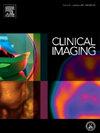Deep learning reconstruction for T2-weighted and contrast-enhanced T1-weighted magnetic resonance enterography imaging in patients with Crohn's disease: Assessment of image quality and clinical utility
IF 1.5
4区 医学
Q3 RADIOLOGY, NUCLEAR MEDICINE & MEDICAL IMAGING
引用次数: 0
Abstract
Purpose
To investigate the image quality of deep learning-reconstructed T2-weighted half-Fourier single-shot turbo spin echo (DL T2 HASTE) and contrast-enhanced T1-weighted volumetric interpolated breath-hold examination (DL T1 VIBE) of magnetic resonance enterography in patients with Crohn's disease.
Methods
Ninety-three patients for the comparison between T2 HASTE and DL T2 HASTE, and forty-two patients for the comparison between T1 VIBE and DL T1 VIBE were enrolled. Two reviewers assessed image quality using 5-point scale scoring, and subjective reviewer preferences. Acquisition times were also compared. The diagnostic performance for the detection of active inflammation was evaluated in three bowel segments (ileum, terminal ileum, and right colon).
Results
The interobserver agreement on image quality was better for T2 HASTE (0.624, standard error 0.083), and T1 VIBE (0.53, SE 0.113) than for DL T2 HASTE (0.443, SE 0.111) and DL T1 VIBE (0.173, SE 0.153). The mean image quality scores showed no significant differences between T2 HASTE and DL T2 HASTE images, as well as between T1 VIBE and DL T1 VIBE images (p > 0.05). Both reviewers preferred T2 HASTE over DL T2 HASTE, although the preference between T1 VIBE and DL T1 VIBE was controversial. The acquisition times were shorter for DL T2 HASTE (16.17 ± 2.53 s) and DL T1 VIBE (14.19 ± 0.84 s) compared to T2 HASTE and T1 VIBE. The per-segment diagnostic performance for detecting active inflammation was identical between T2 HASTE and DL T2 HASTE.
Conclusion
DL-reconstruction allows one-breath hold scan while maintaining image quality in both T2 HASTE and T1 VIBE images.
克罗恩病患者t2加权和对比增强t1加权小肠磁共振成像的深度学习重建:图像质量和临床应用评估
目的探讨克罗恩病(Crohn's disease)患者的深度学习重建T2加权半傅立叶单次涡轮自旋回波(DL T2 HASTE)和对比增强T1加权容积内插式憋气检查(DL T1 VIBE)的图像质量。方法入选93例患者进行T2 - HASTE与DL - T2 - HASTE对比,42例患者进行T1 - VIBE与DL - T1 - VIBE对比。两名评论者使用5分制评分和主观评论者偏好来评估图像质量。获取时间也进行了比较。在三个肠段(回肠、回肠末端和右结肠)评估活动性炎症的诊断性能。结果T2匆忙(0.624,标准误差0.083)和T1 VIBE(0.53,标准差0.113)的观察者间图像质量一致性优于DL T2匆忙(0.443,标准差0.111)和DL T1 VIBE(0.173,标准差0.153)。T2 HASTE与DL T2 HASTE图像、T1 VIBE与DL T1 VIBE图像的平均图像质量评分均无显著差异(p >;0.05)。尽管T1 VIBE和DL T1 VIBE之间的偏好存在争议,但两位评论者都更喜欢T2 HASTE而不是DL T2 HASTE。与T2 HASTE和T1 VIBE相比,DL T2 HASTE和DL T1 VIBE的采集时间分别为16.17±2.53 s和14.19±0.84 s。t2haste和DL T2 HASTE检测活动性炎症的每节段诊断性能相同。结论在T2 HASTE和T1 VIBE图像中,dl重建可以在保持图像质量的前提下进行一次屏气扫描。
本文章由计算机程序翻译,如有差异,请以英文原文为准。
求助全文
约1分钟内获得全文
求助全文
来源期刊

Clinical Imaging
医学-核医学
CiteScore
4.60
自引率
0.00%
发文量
265
审稿时长
35 days
期刊介绍:
The mission of Clinical Imaging is to publish, in a timely manner, the very best radiology research from the United States and around the world with special attention to the impact of medical imaging on patient care. The journal''s publications cover all imaging modalities, radiology issues related to patients, policy and practice improvements, and clinically-oriented imaging physics and informatics. The journal is a valuable resource for practicing radiologists, radiologists-in-training and other clinicians with an interest in imaging. Papers are carefully peer-reviewed and selected by our experienced subject editors who are leading experts spanning the range of imaging sub-specialties, which include:
-Body Imaging-
Breast Imaging-
Cardiothoracic Imaging-
Imaging Physics and Informatics-
Molecular Imaging and Nuclear Medicine-
Musculoskeletal and Emergency Imaging-
Neuroradiology-
Practice, Policy & Education-
Pediatric Imaging-
Vascular and Interventional Radiology
 求助内容:
求助内容: 应助结果提醒方式:
应助结果提醒方式:


